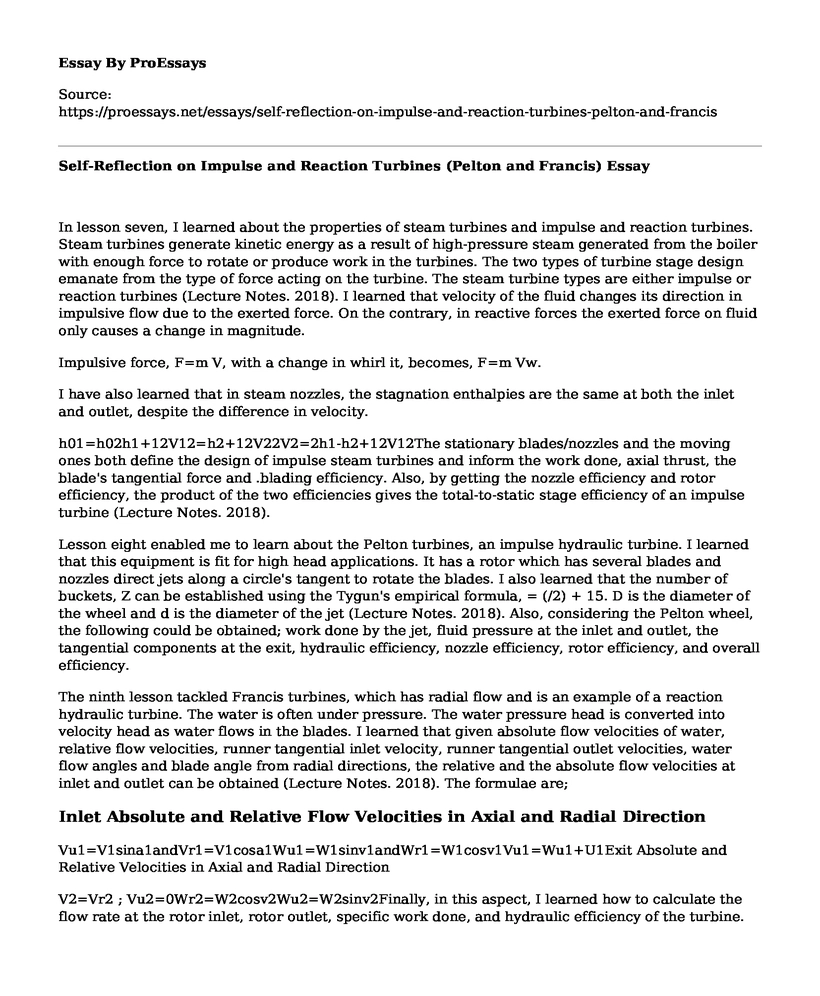In lesson seven, I learned about the properties of steam turbines and impulse and reaction turbines. Steam turbines generate kinetic energy as a result of high-pressure steam generated from the boiler with enough force to rotate or produce work in the turbines. The two types of turbine stage design emanate from the type of force acting on the turbine. The steam turbine types are either impulse or reaction turbines (Lecture Notes. 2018). I learned that velocity of the fluid changes its direction in impulsive flow due to the exerted force. On the contrary, in reactive forces the exerted force on fluid only causes a change in magnitude.
Impulsive force, F=m V, with a change in whirl it, becomes, F=m Vw.
I have also learned that in steam nozzles, the stagnation enthalpies are the same at both the inlet and outlet, despite the difference in velocity.
h01=h02h1+12V12=h2+12V22V2=2h1-h2+12V12The stationary blades/nozzles and the moving ones both define the design of impulse steam turbines and inform the work done, axial thrust, the blade's tangential force and .blading efficiency. Also, by getting the nozzle efficiency and rotor efficiency, the product of the two efficiencies gives the total-to-static stage efficiency of an impulse turbine (Lecture Notes. 2018).
Lesson eight enabled me to learn about the Pelton turbines, an impulse hydraulic turbine. I learned that this equipment is fit for high head applications. It has a rotor which has several blades and nozzles direct jets along a circle's tangent to rotate the blades. I also learned that the number of buckets, Z can be established using the Tygun's empirical formula, = (/2) + 15. D is the diameter of the wheel and d is the diameter of the jet (Lecture Notes. 2018). Also, considering the Pelton wheel, the following could be obtained; work done by the jet, fluid pressure at the inlet and outlet, the tangential components at the exit, hydraulic efficiency, nozzle efficiency, rotor efficiency, and overall efficiency.
The ninth lesson tackled Francis turbines, which has radial flow and is an example of a reaction hydraulic turbine. The water is often under pressure. The water pressure head is converted into velocity head as water flows in the blades. I learned that given absolute flow velocities of water, relative flow velocities, runner tangential inlet velocity, runner tangential outlet velocities, water flow angles and blade angle from radial directions, the relative and the absolute flow velocities at inlet and outlet can be obtained (Lecture Notes. 2018). The formulae are;
Inlet Absolute and Relative Flow Velocities in Axial and Radial Direction
Vu1=V1sina1andVr1=V1cosa1Wu1=W1sinv1andWr1=W1cosv1Vu1=Wu1+U1Exit Absolute and Relative Velocities in Axial and Radial Direction
V2=Vr2 ; Vu2=0Wr2=W2cosv2Wu2=W2sinv2Finally, in this aspect, I learned how to calculate the flow rate at the rotor inlet, rotor outlet, specific work done, and hydraulic efficiency of the turbine.
Work done: w=U1Vu1-U2Vu2Torque: t=mr1Vu1-r2Vu2Hydraulic efficiency: ih=wgHe=U1Vu1-U2Vu2gHH is the turbine head.
References
Lecture Notes. (2018). Lesson Eight: Hydraulic Turbines, Penton Turbines.
Lecture Notes. (2018). Lesson Nine: Hydraulic Turbines, Francis Turbines.
Lecture Notes. (2018). Lesson Seven: Impulse and reaction turbines.
Cite this page
Self-Reflection on Impulse and Reaction Turbines (Pelton and Francis). (2022, May 09). Retrieved from https://proessays.net/essays/self-reflection-on-impulse-and-reaction-turbines-pelton-and-francis
If you are the original author of this essay and no longer wish to have it published on the ProEssays website, please click below to request its removal:
- Flat Earth vs. Round Earth - Argumentative Essay
- The Relation Between Golden Ratio and Beauty of Human Faces Essay
- Discover the Fascinating Origin of the Ratio Pi - Essay Sample
- Unveiling the Chemistry Connection: Physical Attraction & Social Interactions - Essay Sample
- Essay Example on Calculating Drink Mix Mass for 0.24L Solution
- Essay Sample on Creating My Own Star System: Project S
- Essay Example on Miniaturization - Advancing Medical Tech for Safer Surgeries







